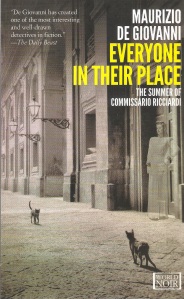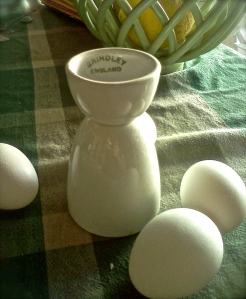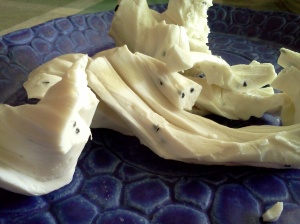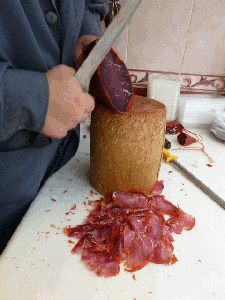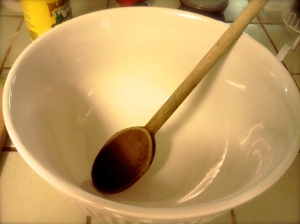It took me an alarmingly long time to finish reading Murakami’s The Wind-Up Bird Chronicle. I’m usually a really quick reader and have to remind myself to slow down and savor– but this time I naturally did just that. I didn’t want the book to end– and sometimes it seemed like it never would!
With the last of my Amazon credits, I bought the newest Murakami, with its pretty cover, for a steal. There have been excerpts of it in The New Yorker, so I wanted my memories of those to get dusty before I delved into the book properly. Do you ever do that? I can’t remember which author it was now, but not too long ago I eagerly picked up a new collection only to find that I’d read most of it in pieces and it didn’t feel like I was reading anything new at all! It’s funny how in music, I like that. With reading, I don’t. Anyway, so I wanted to forget the pieces of Murakami I’d read in the magazine, so I thought I’d read the one book that everybody else seemed to have read but me. Seriously, if anyone ever wanted to label me a hipster, I’m pretty sure I could stymie them by pointing out that I just finished reading The Wind-Up Bird Chronicle this month and so couldn’t possibly be fashionable enough to be a hipster– if they existed, because I really don’t think they actually do. I think they are an imaginary group of people invented by people who are terrified that somebody might be trendier than them. [Related: I just Googled “what is a wind up bird” because isn’t it supposed to be a real bird, too? And there are So Many Tattoos. So many.]
I loved the detailed density of the book, and the squishy plot, and all the World War II passages interspersed in teeny tiny italics. That font made me need bifocals even more than I already do. I hardly ever use the font-changing function on my Kindle, but now I see why it exists. I read this book in paperback form, though, and I’m glad I did. I like the Kindle better for things I suspect I might not want to read again. The classics, however, I still like to hold in my hot little hands.
I identified with jobless Toru and the way he passed his time before things got really crazy– though my favorite character by far was May Kasahara. I didn’t find her particularly morbid, as many reviewers have. Does that mean that I’m morbid, too? It probably does. Sometimes, when I’m doing something in the kitchen, I pause and look around and think, “How many of these things will outlive me? What will somebody else be using from my kitchen sixty years from now?” It sure makes you look at your forks and mugs in a new way, I’ll tell you that.
Also, the way Toru passed through the well wall and reality and time– I loved that. It felt so real, even more real than the bits that were supposed to be in the present reality. Perhaps it was just that those moments felt so much more intense, and my brain was on high alert trying to make sense of it all, and so it felt more real. At any rate, this is the sort of book I’ll reread, so I’m glad a got a paper copy. I ordered from Amazon, used, and it ended up coming from a little place in Berkeley, and the book itself was stamped all over as having come from the discard pile at the Berkeley Public Library! I like getting used books– especially used library books, since then I can see where they were read– and I like imagining who read the book before me. Were they at home? On the toilet? In a cafe? Did they have cats? Did they hate the book or like it? Sometimes I get more out of used books than new– though the smell of a new book is pretty aesthetically pleasing too.
Just for kicks, here is an interview with Murakami in The Paris Review. I love all of those interviews, and if you don’t read them occasionally, you should.
In other news, I don’t know if you know this, but I can finish off a jar of hot pepper jelly within a week, the whole time bemoaning the fact that it is not spicy enough. To fix this, I made myself some Hot Pepper Chutney. It was fan-freaking-tastic. I winged it with the contents of my CSA box that I needed to use up, so the measurements are a little funky (as always).
Hot Pepper Chutney
1 pint plums, pitted and chopped
1 shallot, diced
2 serranos, deseeded to taste, diced
1/2 a yellow bell or Spanish pepper
an equal or slightly less than equal weight of sugar
dash curry powder
star anise
3 cardamom pods
3 cloves
juice of one lime
(depending on the juiciness of your plums, you may need a splash of water)
Let it all simmer for about twenty minutes, cool slightly, then pour into a waiting jar. I should probably get all technical about boiling jars and stuff, but I usually just make one jar at a time and eat it up fairly quickly, so I don’t. Also: I let mine simmer too long while I talked on the phone with my mom, so it’s almost like candy and I have to melt it in the microwave to scoop to out. So let that be a lesson to you! Don’t talk on the phone while you’re trying to make a chutney.

Members of the Women’s Institute hard at work making jam in the Peace Hall (an army hut converted into a village hall) at Rowney Green, Worcestershire. Labelling the jam jars in the foreground are Mrs Lee (left) and Mrs Dodd. Weighing the fruit in the centre of the photograph is Mrs Nutting. Another WI member can be seen behind her, also hard at work. The fruit was provided by people in the village, from their own gardens, and the sugar came from the government. According to the original caption, this centre has made nearly a ton and three-quarters of jam in the three seasons since the scheme began.

